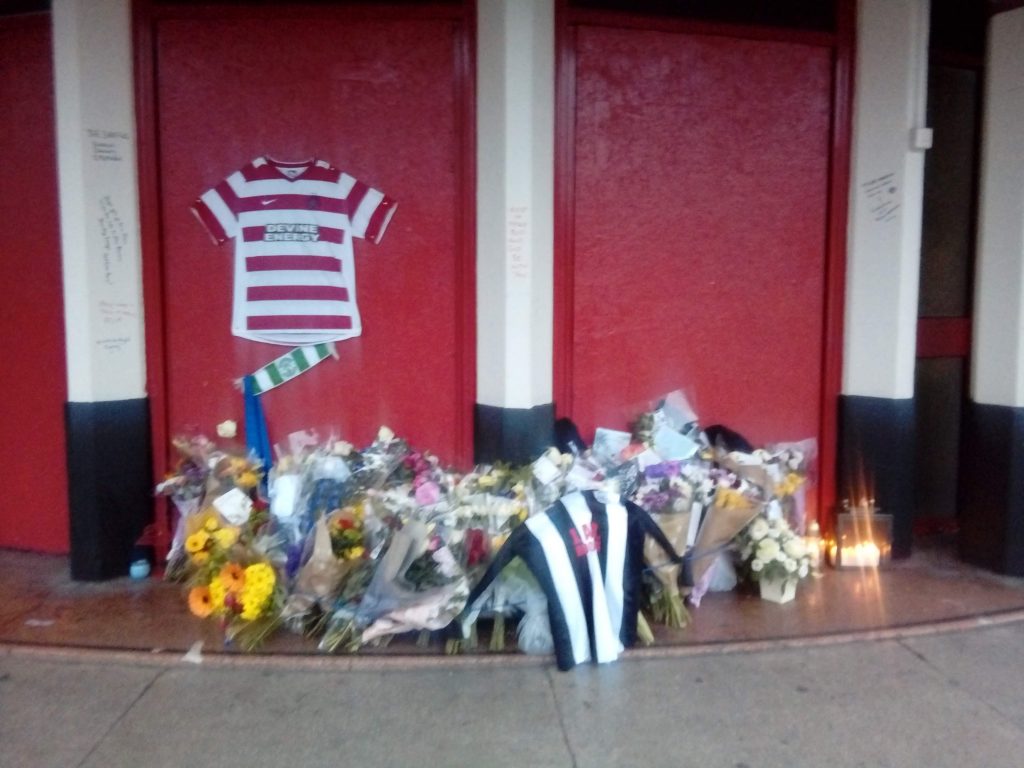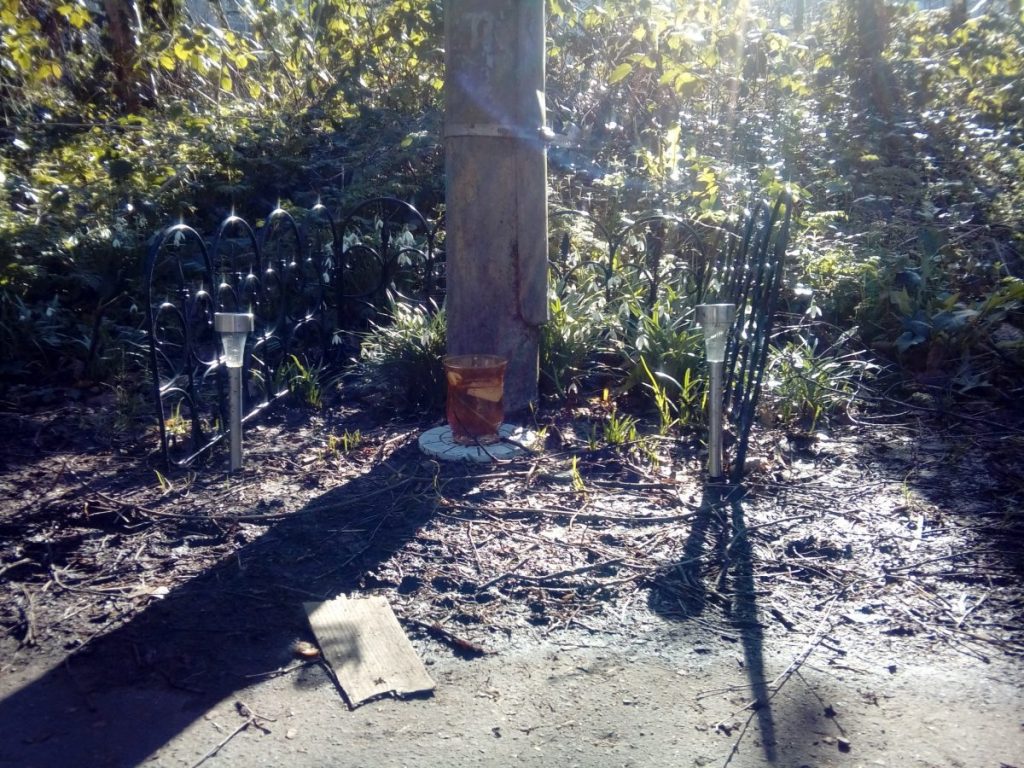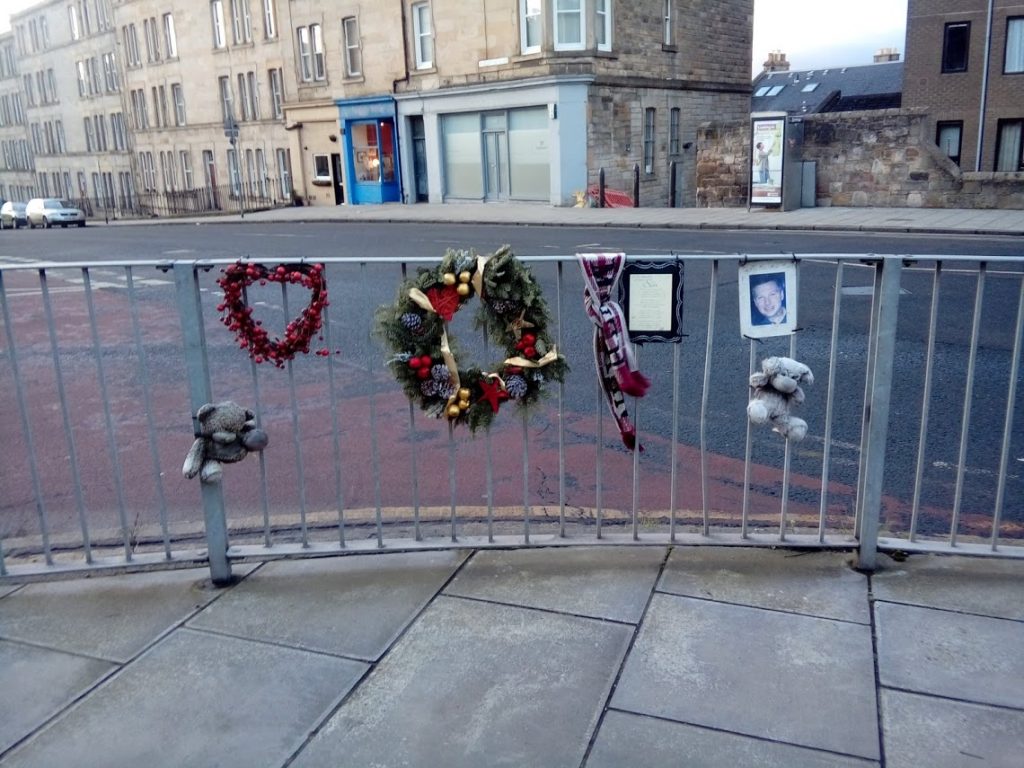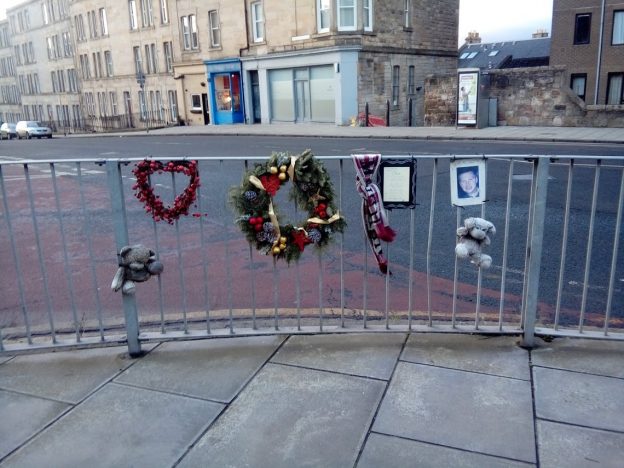By David G. Robertson
Were there always little makeshift shrines to dead people around the city?
I ask in all seriousness. I grew up in Inverness but ended up in Leith about fifteen years ago, and since then I have been fascinated by the makeshift memorials that I began to see popping up every few months. Like roadside shrines.
 Usually they are for young who have died in unfortunate circumstances: a young man who was attacked late at night around New Year; where a child was hit by a car; where a heroin addict died after a fight outside Boots as they waited for their methadone prescription. There’s an unusual one on a cycle path rather than a pavement, but I’m not sure about the details there. It is interesting to note the similarities among the features, however: football colours are typical, as well as other hobbies, like music; flowers are always present, and candles. So while there is (usually) no explicitly religious content, there are recognizable funerary symbols.
Usually they are for young who have died in unfortunate circumstances: a young man who was attacked late at night around New Year; where a child was hit by a car; where a heroin addict died after a fight outside Boots as they waited for their methadone prescription. There’s an unusual one on a cycle path rather than a pavement, but I’m not sure about the details there. It is interesting to note the similarities among the features, however: football colours are typical, as well as other hobbies, like music; flowers are always present, and candles. So while there is (usually) no explicitly religious content, there are recognizable funerary symbols.
 Leith’s an interesting part of Edinburgh. For a long time it was very rundown, and when I moved to Edinburgh in the 1990s (around the time Trainspotting was released) it was still known as “The Heroin Capital of Europe”; now it has three different Michelin Starred restaurants and one of Britain’s top tourist attractions. So unlike, say, Morningside or Stockbridge, it’s not very middle-class – more a few rich people and then a BIG gap before you get down to folk like me. But Leith also has a Catholic heritage, even if most people don’t realise why Hibs fans are referred to as “Huns”. So maybe these kinds of spontaneous shrines were always something that happened in Leith, and I didn’t see them before because I was in Calvinist Inverness. I wonder, then, if they are common in Glasgow? [Update: Marion Bowman just shared a photo of one for a Big Issue seller in Bath).
Leith’s an interesting part of Edinburgh. For a long time it was very rundown, and when I moved to Edinburgh in the 1990s (around the time Trainspotting was released) it was still known as “The Heroin Capital of Europe”; now it has three different Michelin Starred restaurants and one of Britain’s top tourist attractions. So unlike, say, Morningside or Stockbridge, it’s not very middle-class – more a few rich people and then a BIG gap before you get down to folk like me. But Leith also has a Catholic heritage, even if most people don’t realise why Hibs fans are referred to as “Huns”. So maybe these kinds of spontaneous shrines were always something that happened in Leith, and I didn’t see them before because I was in Calvinist Inverness. I wonder, then, if they are common in Glasgow? [Update: Marion Bowman just shared a photo of one for a Big Issue seller in Bath).
 Or maybe they’re a recent phenomenon. Our Instagram feed has included several photos of padlocks appearing on fences in popular tourist spots, and in the last few years the practice of rubbing the toe of the statue of John Knox on the Royal Mile has gone from something specific to philosophy graduates to all tourists, and has now spread to Greyfriar’s Bobby’s nose, 100 yards along George IV Bridge. These rituals are certainly changing over a relatively short period of time, although a serious dive into the broader sociological reasons why would require more space than a blog post would allow. But it is certainly interesting to speculate on these shrines being members of the public reclaiming what had traditionally been a function of religious institutions in a post-Christian Scotland.
Or maybe they’re a recent phenomenon. Our Instagram feed has included several photos of padlocks appearing on fences in popular tourist spots, and in the last few years the practice of rubbing the toe of the statue of John Knox on the Royal Mile has gone from something specific to philosophy graduates to all tourists, and has now spread to Greyfriar’s Bobby’s nose, 100 yards along George IV Bridge. These rituals are certainly changing over a relatively short period of time, although a serious dive into the broader sociological reasons why would require more space than a blog post would allow. But it is certainly interesting to speculate on these shrines being members of the public reclaiming what had traditionally been a function of religious institutions in a post-Christian Scotland.
Instead, I want to end on a point about how we read data for change. To assume that such change was a new phenomenon would be an error, if I didn’t have data from the period before. Just as it would be wrong to assume that sexual fetishes only began with the Kinsey Report, to assume that popular religious practices only started when scholars started to record them may be making the tail wag the dog. As I argued in a previous post, to assume that social behaviours are static and unchanging until the scholar casts their gaze upon it is rather colonial in itself, as though everything “primitive” (be that the colonies or the proles) never changed until it was forced on them. We see this much change and innovation in a few square miles over ten years – what would a history of any of the supposedly monolithic “World Religions” look like with this level of detail? How well would any of the claims to continuity, consistency and tradition hold up?

